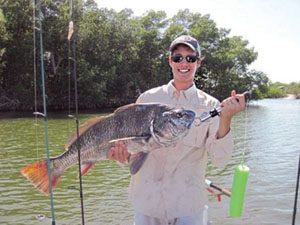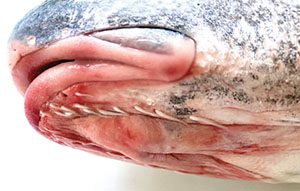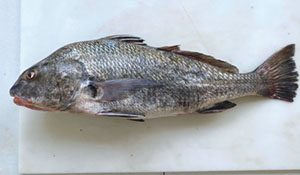
Black Drum, Pogonias cromis
Florida Record:
96 pounds, Caught in Fernandina Beach
International Game Fish Association World Record:
113 pounds, 1 ounce, caught in Delaware
The King of the Drum, black drum are called a variety of names from “puppy drum” to “big uglies,” but I prefer to call them “Kings,” as they are the largest of the drum species, reaching over 50 inches long and weighing over 100 pounds. These neat fish are related to the famous red drum, aka redfish, but belong in a genus of their own.

Black drum have a large geographic range, which covers most of the Western Atlantic. These fish can be spotted from Nova Scotia down to Argentina. Since this species is so widespread, there may be differences in age, growth and spawning information, depending on latitude. As you can imagine, the Chesapeake Bay drum encounter different environmental conditions than ones found in Texas.
Black drum are a largely estuarine species, inhabiting coastal sandy bottom, oyster reefs, mud flats, river mouths and bridge pilings. These fish feed primarily on mollusks and crustaceans, using a set of powerful jaws in their throats, called pharyngeal jaws, to crush up the shells of their prey.
Black drum live long with lifespans of over 35 years. During my literature review, I came across a paper that aged one drum in the Chesapeake Bay at 59 years old. This species matures at 4-5 years of age, which corresponds to 24-26 inches in length.
Black drum breed at night in passes and channels during the late fall to early spring. A female black drum can spawn multiple times during this period and can produce anywhere from 11to 60 million eggs during a season.


The worms can be trimmed out of the fillet (that’s still delicious) and aren’t too hard to spot. I tend to release drum larger than about 15 pounds to avoid carving up the fillet too much and prefer to eat small black drum over red drum due to their great flavor, which may be a result their invertebrate diet. Drum are listed as both “best” and “good” seafood choices when considering sustainability of the species from the Monterey Bay Seafood Watch.
— Michael Sipos is the Florida Sea Grant agent for UF/IFAS Extension,
an equal opportunity institution. Contact him at sipos624@ufl.edu.
For more fishy content and updates on upcoming educational
programs, please check out the Sea Grant Facebook page, YouTube
Channel, Instagram listing or Michael Sipos’ UF/IFAS blog.
